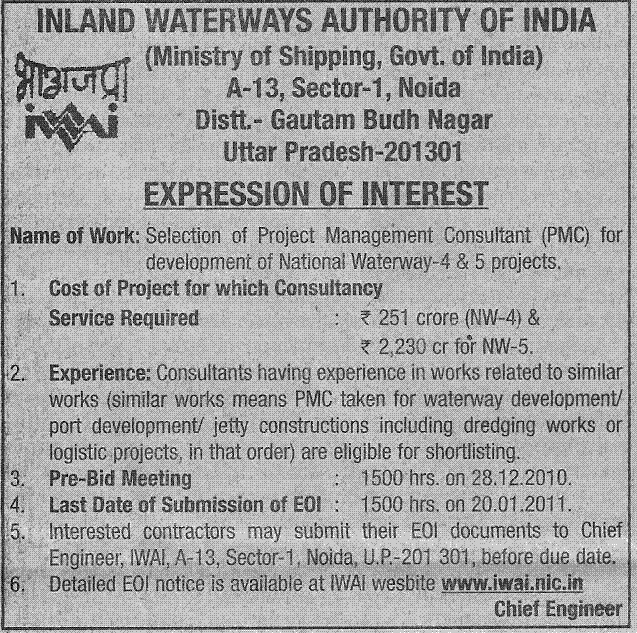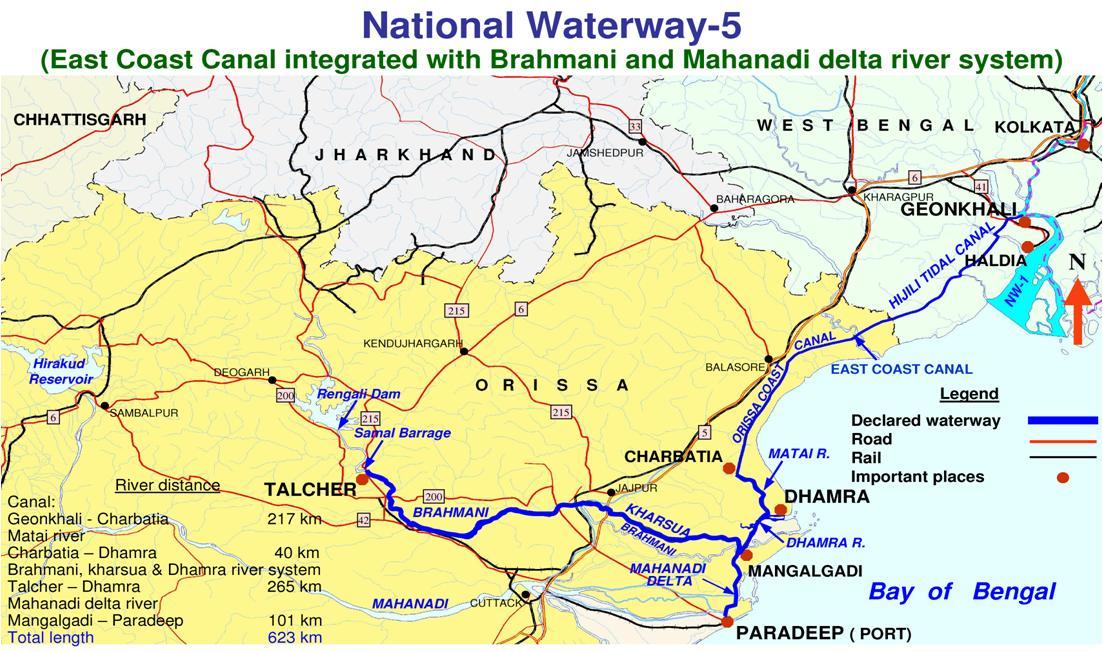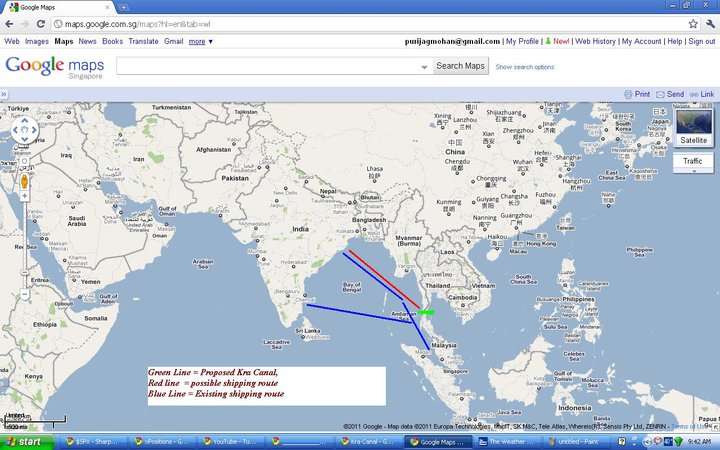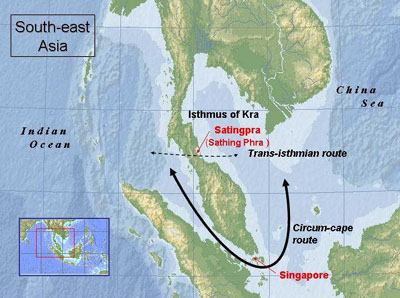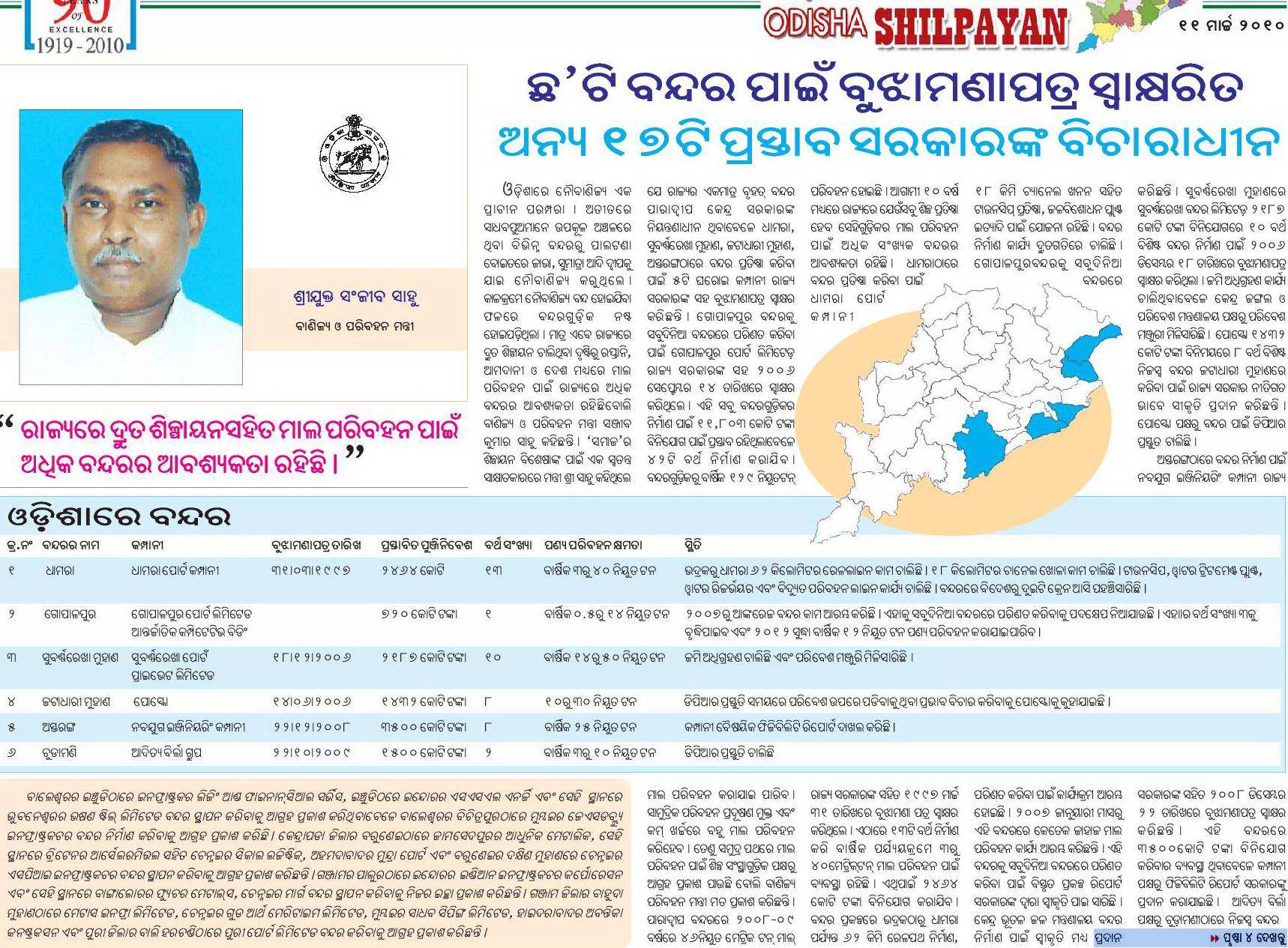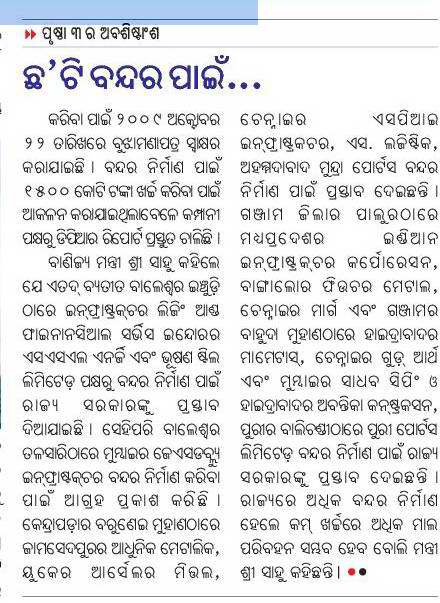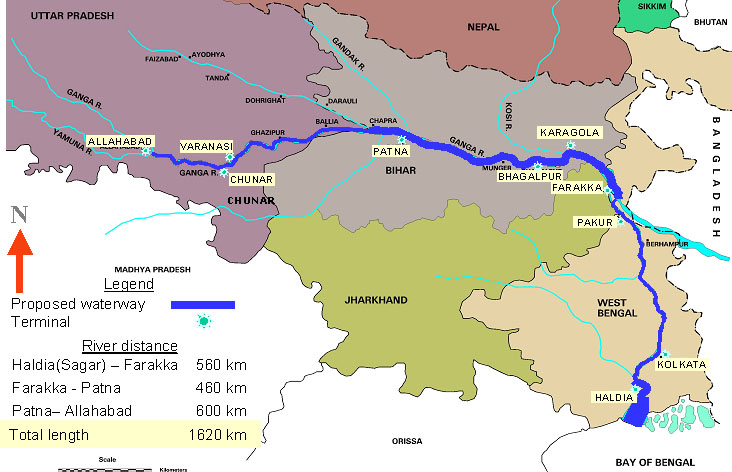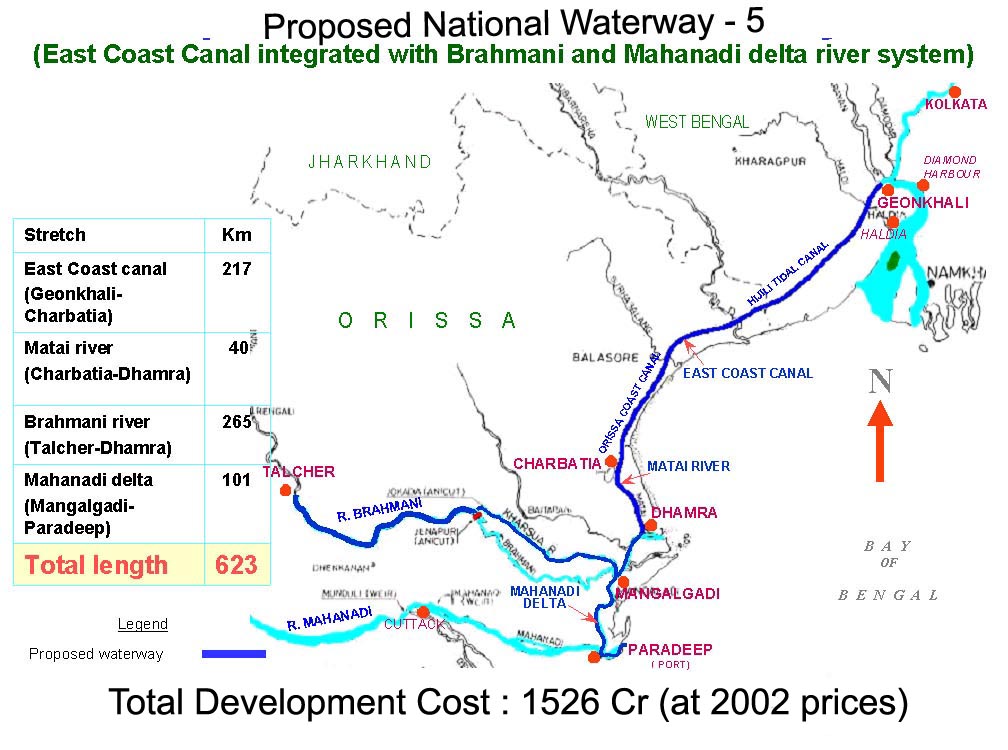Update: It was also passed in the Rajya sabha on 24th October 2008.
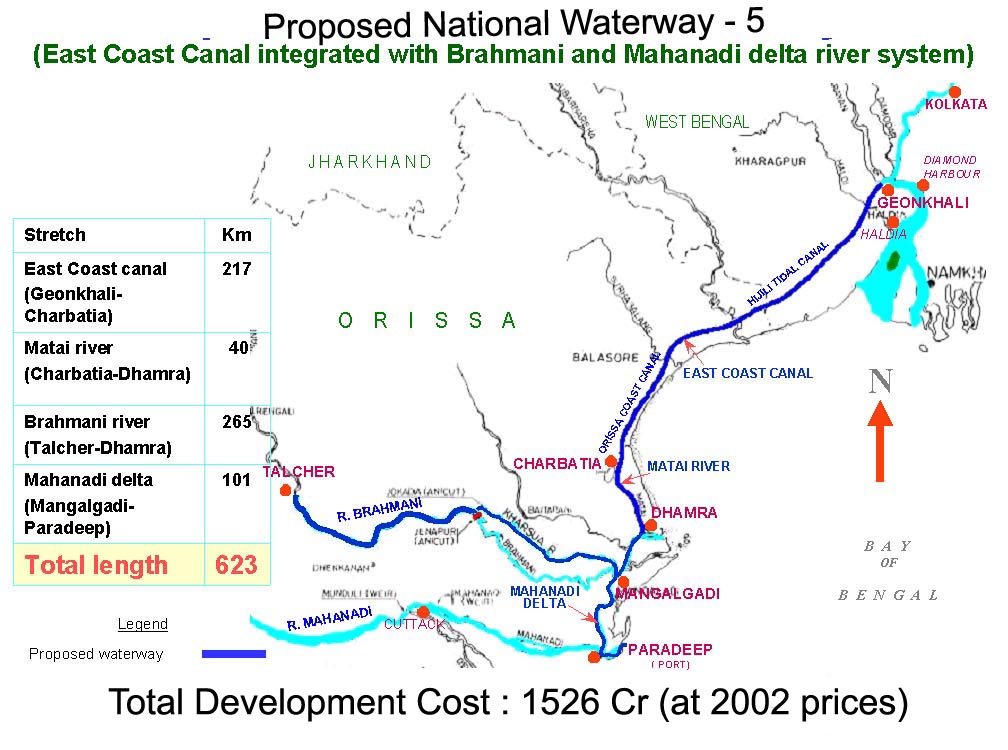
Following is from the Lok sabha Synopsis of 23rd Ocvtober 2008.
NATIONAL WATERWAY (TALCHAR-DHARMA STRETCH OF RIVERS, GEONKHALI-CHARBATIA STRETCH OF EAST COAST CANAL, CHARBATIA-DHAMRA STRETCH OF MATAI RIVER AND MAHANADI DELTA RIVERS) BILL-2006
AND
NATIONAL WATERWAY (KAKINADA-PONDICHERRY STRETCH OF CANALS AND THE KALUVELLY TANK, BHADRACHALAM-RAJAHMUNDRY STRETCH OF RIVER GODAVARI AND WAZIRABAD-VAJAYAWADA STRETCH OF RIVER KRISHNA) BILL-2006
THE MINISTER OF SHIPPING, ROAD TRANSPORT AND HIGHWAYS (SHRI T.R. BAALU) moving the motion for consideration of Bills, said: From time immemorial, inland water transport has served as a cheap and economic means of transport in India. With the advent of faster means of transport, i.e., rail, road and air, inland water transport has got neglected. Inland water transport has, however, maintained its edge over the other modes of transport in certain areas where it enjoys natural advantages. Its energy efficiency, low pollution and potential for employment generation are universally accepted. Since independence, the Government is seized of the need for developing inland water transport infrastructure to restore its rightful place in the overall transport scenario of the country. The subject of inland water transport finds place in all the three Lists of the 7th Schedule to the Constitution of India. The role of the Union is, however, limited to regulating shipping and navigation on the national waterways declared, as such, by Parliament. The responsibility and executive authority for development and maintenance of all waterways other than national waterways rest with the State Governments. Keeping in view the slow pace of the development of inland water transport in our country, several Committees were constituted by the Government of India which have recommended declaration of certain important inland waterways as national waterways. The Government of India has constituted Inland Waterways Authority of India for development, maintenance and regulation of national waterways for shipping and navigation. The infrastructure facilities on the existing three national waterways are being created by it to make them fully functional. Most of the State Government do not have resources to develop their waterways for shipping and navigation due to which most of the waterways remained totally neglected and unexploited for navigation.
Before a waterway can be considered for being declared as a national waterway, it is essential to undertake techno-economic feasibility study including hydrographic survey and traffic studies of such waterways to assess the extent of improvement works required for their development and their financial implications. Based on this study and the potential of improvements in inland water transportation, it is now proposed to declare some waterways mentioned in the Bills as national waterways.
SHRI DHARMENDRA PRADHAN: Infrastructural development is very important for economic development of our country. Though, delayed, but then it is appreciable that a proper thinking regarding waterways in the country is taking shape. Three waterways of Orissa have been mentioned. I would like to mention Talwer. It will become an important waterway. About 60 million tonne of coal is produced in this area. Though, coal is mined, it is arduous to transport it. It will be really a beneficial step to form a waterway for this purpose. A water route has been formed by linking the tributaries of Mahanadi and Brahmani. This is a matter of challenge. We must have water in Brahmani river if at all we have to run it for the year along. If there is a scheme through which Mahanadi water enters into Brahmani, it will keep Brahmani perennial. It shall be really very much beneficial if the Government of India, the Planning Commission and the Minister of Water Resources deliberate in this regard.
…
SHRI LAKSHMAN SETH: We have so many modes of transportation like airlines, railways and roads but waterways is also an important mode of transportation of our cargo and commodities. This is very much neglected in our country. Transportation through water is always cheaper, eco-friendly and environment-friendly so waterways should be developed. Our experience is not so much satisfactory because already long before, one waterway, i.e. Allahabad and Haldia waterway, has been declared as a national waterway. But, I think, infrastructure development has not taken place so far. Terminal has not been done adequately and dredging has not been taken up to the considerable limit. That is why, this important national waterway has not been used properly.
Our nation is facing a severe crisis in fuel. So fuel would be saved. At the same time, environment will be certainly cleaned. That is why there should be a law enforcing the public sector to use this mode of transportation in inland waterways so that the inland water becomes useful and at the same time the nation will also save huge money on account of fuel.
The declaration of these two important waterways as a national waterway will help immensely irrigation and transportation of various types of cargoes and commodities. At the same time, I am requesting the hon. Minister to declare the waterways from Haldia to Sundarban as a national waterway. Another issue which I would like to bring to the notice of the hon. Minister is that in Bangladesh, there is an anchorage on the river Ashuganj. If the Government of India can manage to have this anchorage then the distance between Halida, Kolkata and the North-Eastern States will be reduced remarkably and fuel will also be saved. I congratulate the hon. Minister for bringing this Bill but at the same time I would request him to arrange adequate fund for implementation of the various infrastructural facilities. Further, I would request you to look into the interest of the farmers.
SHRI GANESH PRASAD SINGH: The responsibility for the management of rivers lies with the State Governments but they do not have sufficient resources to shoulder this responsibility. The travel by waterways is economical and time saving also. This Bill envisages an Authority for the development of national waterways and sufficient amount of money has also been proposed to earmark for this purpose. So this Bill is a welcome step.
SHRI B. MAHTAB: It is said that the total length of navigational waterways in India is about 14,500 kilometres. Of this, 5,700 kilometres is navigable by mechanically propelled vessels. At present, the inland traffic is estimated at about 1,000 billion tonne kilometers and the inland water transport accounts for barely 0.17 per cent. The House should know that IWT is not only environment-friendly, it is also less capital intensive. Lack of infrastructure, absence of fixed scheduled services, poor navigational aids, lack of connectivity, longer river distances and thin flow of private investment are the major factors that have stifled the development of this mode of transportation. Now we are considering the East Coast canal integrated with the Brahmani River along with Mahanadi Delta Rivers. It is said that around 18.07 million tones of inland water transport traffic is expected to be carried out on the proposed waterway after it is fully development in eight years time. I would like to suggest that the Government should prepare a roadmap for an Integrated Transport Policy for enabling better inter-connectivity amongst the multiple modes of transport. There have to be provisions for an institutional framework for development of inland water transport sector. There is a need to increase cost recovery and also to commercialise IWT industries. An Action Plan should be in place to address the growing demand of repair and service facilities of IWT vessels. I hope, the proposed national waterways will boost the rural economy and help decongestion of roads and rails. I hope it will provide port-hinterland connectivity, especially between Talcher to Dhamra. It will generate employment and also increase tourism activities in that region. I am sure that the Government must have appointed a consultant for undertaking techno-feasibility study and preparation of detailed project report for this waterway. I hope that the interest of Orissa will not be compromised due to development of this proposed national waterway. Lastly, I must say that regular dredging of riverbeds would be necessary. The infrastructure currently available on this waterway is not adequate for safe, convenient and sustained shipping and navigation purposes. Once it is developed, there is ample scope to have substantial quantum of inland water transport traffic, but first the parameters are to be met and that too, within a specific time frame.
SHRI M. SREENIVASULU REDDY: I rise to support this Bill. All of us know that there are different modes of transport. Waterway is the cheapest, though slow. I am happy that Buckingham Canal-which flows through Ongole, which is my Parliamentary Constituency, has been included in this Bill for the development. There has been a lot of pressure from people living in between Buckingham Canal and Bay of Bengal for construction of bridges to enable them to cross the canal. I request that the bridges at the required spots may be constructed immediately. The area covered between Kakinada and Chnnai along with rivers Godavari and Krishna as Waterway is 970 kms. There are 14 terminals that are being planned in this Bill. Out of these 14 terminals, in my Parliamentary Constituency there is only one terminal, which has been stipulated in this Bill. I will request the hon. Minister to include two more terminals namely, at Karedur or Ramayapatnam and Thummalapantawar near Kavali. There is one more important point that waterways do not provide door-to-door service independently. Therefore, it is necessary that these are connected with rail or road modes for total transport linkages. In my Ongole Parliamentary Constituency there is lot of potential in Granite/tobacco/Garments, food grains, firewood, etc. and providing of connected mode of transport to Buckingham Canal will help a lot. The Inland Waterways Authority of India could make the National Waterways functional fully subject to availability of funds. Any delay will only add to the miseries in the field of transport. Hence, I again impress upon both the Central and the State Governments for an urgent action in this regard.
DR. BABU RAO MEDIYAM: Supporting this Bill, I wish to say that the delta region around Krishna Godavari Rivers was developed almost 160 years ago during the British times. The present canal system is being used only for irrigation purposes. These canals are now under the control of the Irrigation Department, and the irrigation canals are being maintained and regulated by the Water Users Associations in our State. Now, these canals are going to be used for navigational purposes and there is a lot to be done in this case. I would request the Minister to take necessary action in this regard, especially on the stretch between Bhadrachalam and Rajahmundry. There is a proposal for a great barrage of Polavaram. This has to be linked to the existing canals. The Irrigation Department is not spending even a pie on these canals. If these canals come under the National Waterways Authority, then what would be the allocation? What is the role of the Water Users Associations? Moreover, the existing terminals on the banks of the River Godavari should be taken care. If ever this Polavaram Dam project comes up, then most of these present terminals would be submerged. To regulate everything, you have to explore this Bhadrachalam-Rajahmundry stretch of canal. A lot needs to be done on the legal and financial front also. Anyhow, I strongly support this Bill and I request this to be amended.
SHRI ALOK KUMAR MEHTA: I support this Bill. I want to impress upon the authorities that, in 1985, the waterway from Allahabad to Haldia had been declared as the National Waterway. One point of this waterway falls in Patna also. Haldia Port is very near to this point. In the beginning, points and ports had been constructed but lot of problems have cropped up, for want of proper dredging. This waterway needs to be cleared.
Similarly, inland waterways system can be given a nod in view of the heavy traffic density in Patna. The UPA Government would indeed do a great job if it declares it a National Waterway and undertake its maintenance and total infrastructure cost as it is beyond the capacity of any State Government alone. However, if they undertake dredging the menace of flood can be averted to some extent along with the development of national waterways.
SHRI S.K. KHARVENTHAN: Inland water transport is an economical, fuel-efficient and employment-oriented transport. The present waterways in the above ways are unsuitable for shipping and navigation. Hence it is necessary to develop the infrastructure in river and canal portions by deepening and widening the bed for safe and convenient shipping operations. The proposed infrastructural developments are planned to be completed within few years period in a phased manner. I request the hon. Minister to take steps for completing the work as early as possible.
With the policy of economic liberalization Government of India has allowed private sectors for port development. Hence, I request the hon. Minister to allow private participation in shipping in these stretches. It will increase the service as well as employment opportunities for unemployed youths. Another important aspect is regarding oil pollution in the above stretches. Government has to take steps to establish Pollution Prevention Equipment in all terminals to protect and safeguard the river environment. The Ministry also must take steps to provide all necessary facilities for day and night navigation. Furthermore, the Government of India has to provide all assistance to states to develop other waterways in various States.
Inland Water Transport is one of the oldest and cheapest modes of transport. But unfortunately, we have failed to develop it. If the Ministry of shipping is taking a serious view on this subject, then it should and must come forward to allow Joint Venture of Private sector participation in this field. The Standing Committee has also recommended Joint venture participation. The Government should also concentrate on providing proper repair and regular servicing facilities for operating vessels in these waterways.
SHRI KHARABELA SWAIN: I thank the hon. Minister for introducing such a Bill. However, I would like to emphasis upon the hon. Minister that nowadays most parts of the East Coast Canal passing through the district of Balasore have been encroached by various people. In some places, there is virtually no sign of any canal because of the shrimp farming. I shall appeal to the hon. Minister that he should see to it that the land which have been encroached by the land mafia should be recovered by the State Government. Let the State Government take very stringent action with regard to this. Then I come to the repair of the embankment. In most places, there is no existence of any embankment now. Those places should be developed. If both sides of the embankment could be developed under the Pradhan Mantri Gram Sadak Yojana, it will also provide very quick communication facilities for the people. This will also provide an embankment for the prevention of floods. Further, in many places, the farmers have put cross bunds. They have raised many other obstacles. Thus there is no drainage water facilities available. Hence if a canal is dug, it could be drained and a proper drainage water facility could be provided there. That would also save a lot of people and a lot of property being destroyed every year due to flood. While dredging this canal, he should also provide for some small bridges across the canal in regular intervals because cattle will cross, because people will be going to their paddy fields for cultivation along with their cattle, bullocks and cows. So, all these things should be provided now in a planned manner.
The hon. Minister is also requested to go for sluice gates in order to prevent the salty water of the sea entering into the paddy fields. I will appeal to the hon. Minister that he should set a time frame for the completion of these projects. Otherwise, for eternity they will remain on paper and they will not be implemented at all.
SHRI ADHIR CHOWDHURY: India has already three National Waterways and we are going to have two more National Waterways. But we have to have some introspection whether just declaring some waterways as National Waterways will serve the desired purpose. India is a country which has been endowed by the nature of so many rivers. In spite of the huge potentiality that we have in our country we are able to exploit a very negligible portion of our waterways. In our multi-mode transport system, inland water is so negligible that inland water transport system enjoys less than one per cent. The fact is that in spite of plenty of potentiality in so far as inland water transport system is concerned, we have grievously failed to exploit the enormous potentiality and the enormous advantages in terms of fuel efficiency, in terms of eco-friendliness.
So, first of all, what I propose to the Government is that we should offer some lucrative incentive to the private sector so that they could be drawn to the inland water transport system. Only by the endeavour of the Government, we cannot attain our desired goal and to draw the attention of the private sector. Our nature has itself done the engineering work for the inland water transport. Therefore, we have the enormous leverage in this sector. The cost of development inland waterways is 5 to 10 per cent of the cost of developing an equivalent rail way or a four-lane expressway. Insofar as maintenance cost is concerned, the maintenance cost of an inland waterway is only 20 per cent of the maintenance cost of an equivalent roadway. However, we have failed to exploit the potentiality.
We know that the entire State of Assam is prone to flood. The highest river route is available in Assam so, if we are able to develop an appropriate inland waterway system in the Assam Region, I think it will be a great benefactor to the entire North-Eastern Region. Furthermore, it will add a new dimension to our Look East Policy also. We can cover the North-East and West Bengal by the inland water transport system and the entire route could be shortened. It will also entail the growth of trade and commerce. The three national waterways are there. I would like to know whether we have achieved the target, the goal before commissioning of the other three national waterways. It will indicate whether the further declaration of national waterways will be lip service or will be a real objective of our country.
I have a little confusion. I would lime to know from the hon. Minister whether this amount of Rs.1,526 crore is the consolidated amount for both the national waterways or this amount pertains only to Geonkhali-Charbatia Stretch of East Coast Canal and the other amount of Rs.542 crore pertains to Kakinada-Pondicherry Stretch of Canal. I once again appreciate our Government for bringing this Bill because when trade and commerce in our country is increasing, naturally we are facing a severe constraint in our existing modes of transport. So, we need other avenues of transport and in this regard, inland waterways could be an ideal mode of transport in our country.
SHRI BHANU PRATAP SINGH VERMA: Transportation of goods by roads is costly. Whenever we have to send food articles to Kolkata, we do not get railway boggies as a result of which these articles of Bundelkhand and nearby areas do not reach Kolkata and other parts of the country. Therefore, we want that inland waterway on the Yamuna river be restored and a port should be constructed at Kalpi Nagar so that unemployed youth of the above area could also get employment there. Moreover, the waterways are also the cheapest means of transportation.
SHRI SURESH PRABHAKAR PRABHU: In fact, for a long-long time, the entire merchandise, the entire trade routes were passing through the great rivers of India. Therefore, the waterways are not something new that we are innovating now. Unfortunately, we neglected it and we are paying a price for it. But I am very happy that now we are going back to the basics and we are now trying to create waterways for the country. It will be cost-effective. There several Ministries dealing with water. The ministry of Shipping is now going to deal with one aspect of that. So, when we are developing waterways. I only hope and wish and really expect that the Ministry of Shipping will take into account the overall needs of the water sector in the country as a whole while planning this. Floods have become common phenomena in India. At the same time, some other parts of the country are constantly facing drought. This is a golden opportunity; when the Minister is trying to create waterways for the country, why not also he integrates the drought and famine phenomena which happens all the time?
SHRI GIRIDHAR GAMANG: I support both these two bills because they would lead to economic development of the country and they would give new life to Indian inland waterways network. There should be integration between your Department and the Department of the concerned State Government. These two Departments will have to be integrated, not financially, but in respect of there aspects the Central Government will have to take the support of the State Government.
SHRI BIKRAM KESHARI DEO: I completely support the Bill and welcome it because this will integrate the entire rivers with one another, and it will be direct link. As the States do not have resources to develop inland waterways, it is high time that the Centre is now concentrating on developing these waterways. Economically it is a very viable project. You can use the flow of water for transportation of goods. There has been a long standing demand in the State of Orissa that an Inland Waterways Regional Office should be opened because Mahanadi delta is a massive delta. This will also enhance export and import activities. Besides that, as Orissa is prone to natural disasters, this East Coast Canal, which we are developing now, will have a deterrent effect on storms and Tsunamis, and it will be a mode of transport to the entire interior Orissa. After Independence, so many big water bodies, infrastructures and big dams have come up. It is because of the formation of these dams and impounding of water, thousands of villages are on the other side of the reservoir thereby creating problems for the people to deliver the goods like PDS, health related activities, development activities, and transportation of people. For example, in my constituency, Upper Indravati project is there. It is a huge inland water reservoir covering 110 square kilometers. It has with four dams and eight dykes. There are about 72 villages on the other side of the reservoir. So, to reach those 6-7 villages, we have to take a detour of nearly 100 kilometres. But if the waterway is there, it will be about within 25 to 30 kimometres. So, I request the hon. Minister, that the Inland Authority should be created for these big reservoirs for movement of PDS and for taking up other Government related activities.
KUNWAR MANVENDRA SINGH (MATHURA): I feel for the first time that after independence such a good bill has been introduced in the Parliament that is a welcome step as it would be beneficial. Before Independence when the East India Company came to India it started inland waterway from East to West. But gradually not much importance was given to it. So its losses are before us today. But today the need of the hour is that we should also gradually undertake such projects for other rivers of the country also. Rs. 1000 crore were provided for cleansing the Yamuna river. But we see that even after spending so much of money, sewer water and industrial waste are still being discharged into Yamuna which is really a cause of grave concern.
A project for the cleaning of the Rivers was undertaken during the regime of Late Rajiv Gandhiji, however, no special attention has been paid to this project. River Yamuna is in a very bad condition today. But we can develop it for waterways which could include passenger transport as well. If we can start waterways for passenger transport from Delhi to Agra, lakhs of tourists would travel thereby, thus developing it as a good mode of transport. Besides, we can clean and beautify river Yamuna. At the same time, rivers of the country need to be linked, as it would increase the flow of water in the river. We would be able to ward off the damage caused by the floods and save crores of rupees and many lives. If we construct dams on the river, we would be able to generate hydro-power and provide irrigation facilities thereby curbing the menace of floods. Likewise, a pollution free environment would be created and cheap mode of transport will be in place reducing the pressure on the roads. It would help to set up new industries along the rivers in the remote areas. It would generate employment and develop the rural areas. I would like to suggest that we need to formulate a comprehensive scheme for the rivers of the country. Hon’ble Minister has taken a good initiative and I hope in the time to come, we will be able to develop a viable system and clean environment through our rivers in the country.
SHRI LAKSHMAN SINGH: Hon’ble Minister deserves to be congratulated for the Authority, which is sought to be set up. However, we hope that the potential for the development through the rivers need to be properly addressed and considered. We hope him to work with the national perspective. We have a great potential in the North India. Likewise, there is a major river, Chambal, which flows perennially. It has been included in the linking project too. This river passes through three states i.e. Uttar Pradesh, Madhya Pradesh and Rajasthan. If a waterway is developed through this river connecting these states, the problem of dacoity would be addressed to a great extent. Besides, this mode of transport would be fairly cheaper and economical.
SHRI T. R. BAALU replying said: First of all, I would like to thank all the hon. Members who have deliberated in this discussion. Definitely, all the deliberations that have been made by them are a matter of great guidance for me. Since time immemorial, inland waterways transport has served as cheap and economic means of transport. People are using this waterway transport as they are conscious of the issue of environment. As you know, Allahabad-Haldia is Waterway No. 1, Sadiya-Dhubri is Waterway No. 2, and Kollam-Kottappuram is Waterway No. 3. However, in all these three waterways, we could not achieve much success. 1985 onwards the Governments have not given the necessary attention towards this waterway system. The waterway transport has not developed to the extent other countries have developed it. I would like to draw the attention of the august House to what we have done to develop inland waterways during the UPA period. A revised action plan for making the existing three national waterways fully operational has been drawn and it will be functional from 2010 onwards. Funds have been provided to the extent of Rs. 961.64 crore. Investment of approximately Rs. 415 crore has been made between 2004 and 2009. Seven terminals on National Waterway No. 3 at a cost of Rs. 10.32 crore have been constructed and commissioned. Low level jetty of a new fixed terminal capable of handling containers was constructed at Patna and high level jetty at Patna has been sanctioned. Low level jetty at Pandu, Guwahati, on National Waterway No. 2 is nearing completion, and a high level jetty at Pandu on National Waterway No. 2 is under construction along with container handling cranes. At various floating terminals, floating cranes and shore cranes have been provided. Night navigation facilities have been installed in about 364 kilometres on National Waterway-1; 255 kilometres on National Waterway-2; and 100 kilometres on National Waterway-3. Projects for providing state of the art 24-hour navigational aids on three National Waterways have been sanctioned and are under implementation. Acquisition of six cutter section bridges, six watch boats, and six accommodation boats for carrying out dredging operations on National Waterway-1 and National Waterway-2 have been sanctioned. Approval for setting up of six joint venture projects is on the anvil. In response to suggestions and views expressed by the hon’ble Members, I would like to say that they would be duly considered . In river Brahmani, accumulation of water will be ensured by constructing five barrages in that particular area. Environmental studies will be made. Irrigation would not be affected. We will definitely ensure that nobody staying nearby would be disturbed. On irrigation and interests of the people living along the waterways, we will definitely consult the State Governments and do the needful. As far as implementation plans are concerned, they have already been drawn and clearance have been obtained from the Planning Commission and the Finance Ministry. Local irrigation interests will be taken care of. We are giving priority to inland waterways transport. We have already done the Techno-Economic Feasibility Study: DPRs are being prepared. The DPRs which are under preparation would take care of terminal construction etc. The social problems will be handled only after providing alternative arrangements. Definitely, we would come forward with an Integrated Water Transport Policy in consultation with all the Departments. After the addition of two national waterways, total length of waterways would become 4,460. By 2020 the share of inland waterways traffic would be not less than two per cent.
An amount of Rs.1525 crore is identified for Talcher-Dhamra waterways and an amount of Rs.542 crore is identified for Kakinada-Pondicherry waterways. An Hon. Member has said that we should encourage Inland Waterways Authority of India to function better by opening a regional office in Orissa. It is proposed to open an office in Orisa; presently, it is planned at Dhamra-Charbatia. We should see that whatever waterways that have already been declared, should be made functional; that is more important.
The Bill, as amended, was passed.
